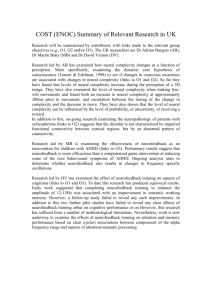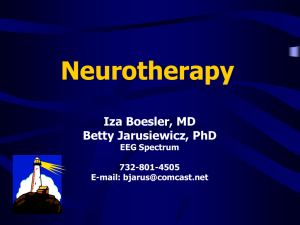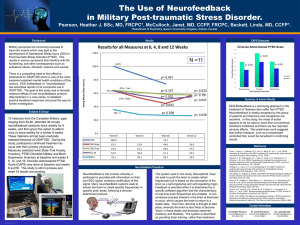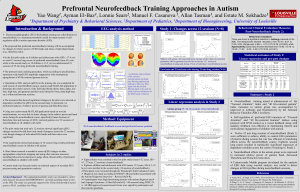Enhancement of Attention and Cognitive Skills Using EEG Based
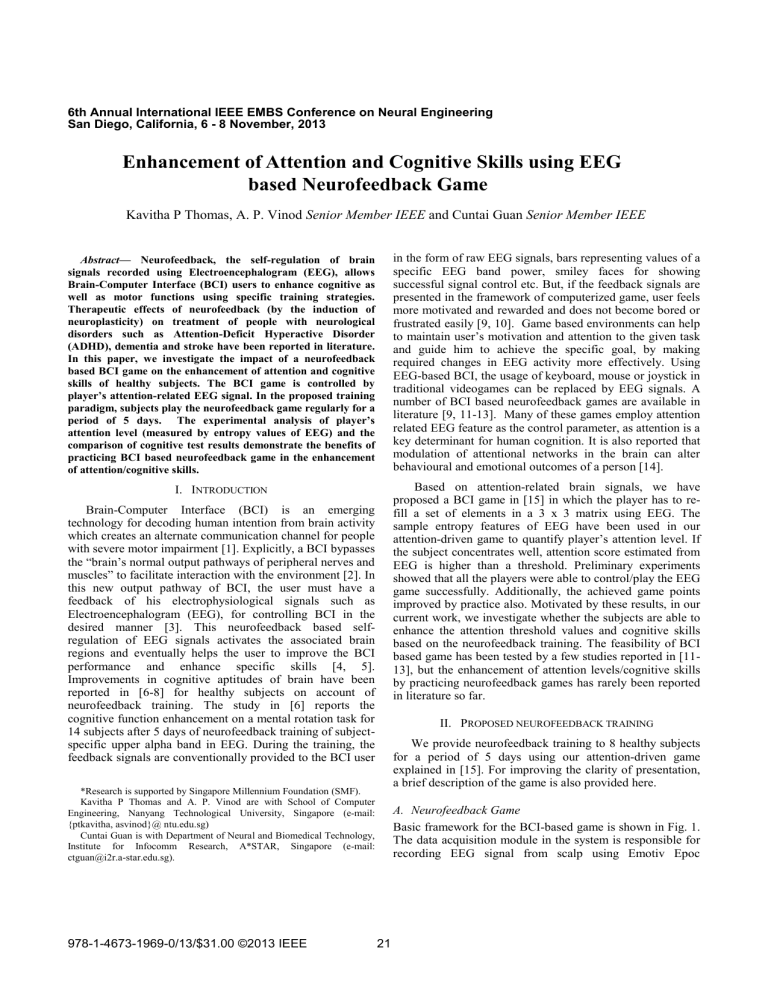
6th Annual International IEEE EMBS Conference on Neural Engineering
San Diego, California, 6 - 8 November, 2013
Enhancement of Attention and Cognitive Skills using EEG based Neurofeedback Game
Kavitha P Thomas, A. P. Vinod Senior Member IEEE and Cuntai Guan Senior Member IEEE
Abstract — Neurofeedback, the self-regulation of brain signals recorded using Electroencephalogram (EEG), allows
Brain-Computer Interface (BCI) users to enhance cognitive as well as motor functions using specific training strategies.
Therapeutic effects of neurofeedback (by the induction of neuroplasticity) on treatment of people with neurological disorders such as Attention-Deficit Hyperactive Disorder
(ADHD), dementia and stroke have been reported in literature.
In this paper, we investigate the impact of a neurofeedback based BCI game on the enhancement of attention and cognitive skills of healthy subjects. The BCI game is controlled by player’s attention-related EEG signal. In the proposed training paradigm, subjects play the neurofeedback game regularly for a period of 5 days. The experimental analysis of player’s attention level (measured by entropy values of EEG) and the comparison of cognitive test results demonstrate the benefits of practicing BCI based neurofeedback game in the enhancement of attention/cognitive skills.
I.
I NTRODUCTION
Brain-Computer Interface (BCI) is an emerging technology for decoding human intention from brain activity which creates an alternate communication channel for people with severe motor impairment [1]. Explicitly, a BCI bypasses the “brain’s normal output pathways of peripheral nerves and muscles” to facilitate interaction with the environment [2]. In this new output pathway of BCI, the user must have a feedback of his electrophysiological signals such as
Electroencephalogram (EEG), for controlling BCI in the desired manner [3]. This neurofeedback based selfregulation of EEG signals activates the associated brain regions and eventually helps the user to improve the BCI performance and enhance specific skills [4, 5].
Improvements in cognitive aptitudes of brain have been reported in [6-8] for healthy subjects on account of neurofeedback training. The study in [6] reports the cognitive function enhancement on a mental rotation task for
14 subjects after 5 days of neurofeedback training of subjectspecific upper alpha band in EEG. During the training, the feedback signals are conventionally provided to the BCI user
*Research is supported by Singapore Millennium Foundation (SMF).
Kavitha P Thomas and A. P. Vinod are with School of Computer
Engineering, Nanyang Technological University, Singapore (e-mail:
{ptkavitha, asvinod}@ ntu.edu.sg)
Cuntai Guan is with Department of Neural and Biomedical Technology,
Institute for Infocomm Research, A*STAR, Singapore (e-mail: ctguan@i2r.a-star.edu.sg). in the form of raw EEG signals, bars representing values of a specific EEG band power, smiley faces for showing successful signal control etc. But, if the feedback signals are presented in the framework of computerized game, user feels more motivated and rewarded and does not become bored or frustrated easily [9, 10]. Game based environments can help to maintain user’s motivation and attention to the given task and guide him to achieve the specific goal, by making required changes in EEG activity more effectively. Using
EEG-based BCI, the usage of keyboard, mouse or joystick in traditional videogames can be replaced by EEG signals. A number of BCI based neurofeedback games are available in literature [9, 11-13]. Many of these games employ attention related EEG feature as the control parameter, as attention is a key determinant for human cognition. It is also reported that modulation of attentional networks in the brain can alter behavioural and emotional outcomes of a person [14].
Based on attention-related brain signals, we have proposed a BCI game in [15] in which the player has to refill a set of elements in a 3 x 3 matrix using EEG. The sample entropy features of EEG have been used in our attention-driven game to quantify player’s attention level. If the subject concentrates well, attention score estimated from
EEG is higher than a threshold. Preliminary experiments showed that all the players were able to control/play the EEG game successfully. Additionally, the achieved game points improved by practice also. Motivated by these results, in our current work, we investigate whether the subjects are able to enhance the attention threshold values and cognitive skills based on the neurofeedback training. The feasibility of BCI based game has been tested by a few studies reported in [11-
13], but the enhancement of attention levels/cognitive skills by practicing neurofeedback games has rarely been reported in literature so far.
II.
P ROPOSED NEUROFEEDBACK TRAINING
We provide neurofeedback training to 8 healthy subjects for a period of 5 days using our attention-driven game explained in [15]. For improving the clarity of presentation, a brief description of the game is also provided here.
A. Neurofeedback Game
Basic framework for the BCI-based game is shown in Fig. 1.
The data acquisition module in the system is responsible for recording EEG signal from scalp using Emotiv Epoc
978-1-4673-1969-0/13/$31.00 ©2013 IEEE 21
Neuroheadset [16] using electrodes AF3, F7, F3, P7, O1,
O2, P8, F4, F8 and AF4 according to the 10-20 international system of EEG electrode placement. The acquired signal is then preprocessed to improve the signal-to-noise ratio. In order to compute the attention score, the sample entropy values of each EEG channel signals are computed [17]. The average value of entropy measures from the mentioned ten
EEG channels represents the attention score of the subject and is passed to control the GUI of the game. The higher the attention level of a subject, the higher the entropy measure
[15]. The GUI developed using C# maintains stable communication with the Emotiv headset. Game GUI displays the attention score in the form of a progress bar and act as a feedback to the player for self-regulating his EEG signal to maintain his attention level above threshold and win more points in the game.
Signal Preprocessing and
Attention score
Computation
EEG Signal
Acquisition
GUI on
Computer
Screen
Feedback
Fig. 1 Framework of the neurofeedback system.
The brain signal controlled Graphical User Interface (GUI) is the essential component of the proposed neurofeedback game. The GUI protocol is designed such that player has to focus on a set of numbers displayed in the form of a 3 x 3 matrix textbox, memorize them and to correctly re-fill the matrix. Subject is able to refill the matrix correctly only if his attention level exceeds a specific threshold. This attention level; the control parameter of game, is continuously provided in the form of a progress bar in the GUI which forms the core neurofeedback element in the game. At first, a set of vacant textboxes in the form of a 3 x 3 matrix are presented to the player in the GUI. Based on the player’s selection of Level-1, Level-2 or Level-3 buttons provided on the gaming interface, the computer screen displays 3, 4 or 5 matrix elements (numerals) respectively. Level-1 is the least difficult level with the least number of elements (3), Level-2 is the medium difficult level with 4 elements and Level-3 is the most difficult level with highest number of elements (5) in a single matrix. Using a fixed subject-specific attention threshold, 8 subjects (neurofeedback group) played all the 3 difficulty level games for a period of 3 days. It was observed that the attention scores and the accuracy of filling matrix elements gradually improve across days [15].
B. Proposed Neurofeedback Training Experiments
Motivated by the preliminary results, we investigate whether the regular practice of this attention-driven game will enhance the attention/cognitive levels of the players. This experiment is designed and conducted for investigating whether the subjects are capable of playing the game with an increased attention threshold by practicing the game regularly over a few days. Another intention was to evaluate the effect of game based neurofeedback training on the cognitive skills of the subjects. In order to achieve these goals, 5 game sessions have been conducted for each subject
22 within the same week from Monday to Friday (with one game session each day) during the proposed training paradigm. Within one session, the subject is required to play one set of difficulty Level-3 game. From Monday to
Thursday, all the subjects play game with the same attention threshold. On the 5 th day, the subject is required to play one set of difficulty level-3 game with an enhanced threshold.
The quantity of enhancement in threshold is determined based on the performance on the 4 th day. However, the amount of threshold enhancement is decided only after getting the player’s consent.
Apart from these neurofeedback experiments, cognitive tests have also been performed on the first and last day of this experiment for assessing the attention/cognitive enhancement of the subjects achieved through this neurofeedback training. The conducted cognitive test is available online, designed for checking subject’s attention, working memory and cognitive skills [18]. It also requires answer selection using keyboard inputs as similar to our proposed game. During the test, the player will be presented with a word and a picture on the computer screen. If the word matches with the picture, the player has to respond
‘YES’ by pressing the right arrow key in the keyboard and if they are different, left arrow key has to be pressed to convey
‘NO’ to the computer. For example, if the word ‘CAT’ and the image of a dog appear on the screen, player has to press left arrow key for correct hit. But, if the word ‘REVERSE’ appears along with word and image pair, player has to reverse the strategy of responding answers. In this case, if the word and object are the same, answer ‘NO’ with left arrow key. If not, answer ‘YES’ with right arrow key. For completing the test, player has to respond to 20 trials.
During this test, the subjects are encouraged to place their index fingers of both hands on the left and right arrow keys in preparation for a response. The objective of the test is to get as many right answers as fast as possible. At the end of this test, user will be provided with a graph showing the obtained cognitive score, average time taken for answer selection, its standard deviation and percentage of correctly performed trials. This test has been developed in the Institute for Neural Computation at the University of California at
San Diego, and is intended to support standardized cognitive health assessments for all ages and to improve quality of life
[18].
For a better comparison, a control group has also been created and tested with the same design of cognitive test for identical days and times as of neurofeedback group. The control group consists of 8 subjects and all of them performed the cognitive test on Day-1 and Day-5. Control participants did not have to show up on days two to four, but were asked not to expose themselves to exceptional stress. A total of 16 healthy people, 8 in the neurofeedback group (3 females and 5 males, 29.6±2.4 years) and 8 in the control group (2 females and 6 males, 27.1±3.2 years), took part in this experiment. Eight subjects from the neurofeedback group are named as S1, S2, S3, S4, S5, S6, S7 and S8 whereas the control group subjects are named as C1, C2, C3,
C4, C5, C6, C7 and C8 in the sequel.
III.
A NALYSIS AND R ESULTS OF N EUROFEEDBACK T RAINING
The results of the proposed neurofeedback training show the effect of proposed neurofeedback game on the enhancement of threshold on all subjects. It is found that all of the subjects are able to play the game at a higher attention threshold on the final day of experiment, even though the amount of threshold increment is subject-dependent. The threshold value for the Day-5 has been determined based on the entropy values of the respective subjects on Day-4. Most of the subjects are able to offer improved or identical performance on Day-5 with higher threshold compared to that on the previous 4 days with lower threshold. Fig. 2 shows the points achieved by 8 subjects over 5 days. As shown in Fig. 2 the points won on Day-5 with higher threshold are greater than the average performance of the previous 4 days. Additionally, points in subjects 1, 2 and 8 on Day-5 are actually greater than their best performance on those 4 days. The subfigure in Fig. 2 shows the trend line of average points won by all the subjects over 5 days. It can be observed that the performance improves over time and the performance with a higher threshold is almost same with the points won on Day-4 with lower threshold. The improved results over time show the possibility of brain’s attention skill enhancement and ability of subjects which even offers similar or better performance in a higher attention demanding tasks through game based neurofeedback training.
Fig. 2 Points won by 8 subjects over 5 days.
Similar to the points won by the subjects in different days, the variations of obtained attention scores during the game are also analyzed. The maximum point that can be achieved by a player is 30 only as one session of difficulty Level-3 game is played by each subject during this experiment. It is observed that for most of the subjects, the attention score values (estimated from the entropy values of EEG signals) in successful trials improve day by day and all the subjects are able to play the game successfully at a higher threshold. This implies the improved efficacy of all the subjects in selfregulating their EEG signals and maintaining their entropy values at the required level to attain comparatively good points even at a higher threshold on Day-5.
In order to visualize the attention score enhancement across days, the average attention score values over 5 days for all the subjects are plotted in Fig. 3. It can be seen from Fig. 3 that for all subjects, the average score values on Day-5 is higher than the average attention score values over the previous 4 days. The results show that through neurofeedback training, it is possible to make a subject perform as well in a greater attention demanding task. The enhanced entropy measures of the brain signals might be indicating the effect of neurofeedback training on the
23 neurophysiological background of a person’s response to attention based tasks.
Fig. 3 Variation of attention scores in 8 subjects over 5 days.
Note that the enhanced threshold to be utilized on Day-5 is determined based on the performance on Day-4. On Day-4, the attention score values utilized in the game are noted and if more than 80% of the used attention score values are above a particular level (which is higher than the original threshold), that level is taken as the enhanced threshold for the Day-5. However it was asked to the subject on Day-5 whether he is able to play the game with the estimated higher threshold. All the subjects are able to enhance the threshold to some extent from the original threshold. The average increment in threshold among all the 8 subjects is 26.12%. It was found that all subjects except one person are able to achieve points which are better than the average points won with lower threshold on the previous 4 days. Among 8 subjects, the average rate of enhancement in game points equals 11.25% after the neurofeedback training.
Results of the cognitive tests are also discussed here for assessing the cognitive level enhancement of the subjects after the neurofeedback training. As described in Section II,
16 subjects performed cognitive tests on Day-1 and Day-5, 8 in the neurofeedback group and 8 in the control group.
Neurofeedback group underwent the game based training using the proposed game as discussed above whereas no
EEG training was given to the control group.
Fig. 4. Average cognitive scores in control and neurofeedback groups.
Fig. 4 shows the mean and standard deviation of the cognitive scores obtained for all the subjects in both groups.
It can be observed from Fig. 4 that both the control group and neurofeedback group performs better in the final session, but the amount of improvement in the neurofeedback group is better than that of the control group. The slope of the plot in neurofeedback group is higher compared to that in control group which explicitly shows the cognitive skill enhancement achieved through neurofeedback training.
Along with the cognitive score index, other results obtained from the cognitive test such as the response time for the subjects, standard deviation of the response time and accuracy of response are also provided here for analysis.
Figures 5(a) and 5(b) represent the percentage deviations in classification accuracy (blue bar), response time (red bar) and standard deviation of response time (green bars)
respectively for the control group and neurofeedback group respectively on first and last day of the training. It can be observed from the figures that the classification accuracy enhancement is almost the same in both groups, but the response time and standard deviation in response time are significantly reduced in the neurofeedback group compared to those in control group. This comparison of neurofeedback group results with the control group reveals the fact that the improved performance of neurofeedback group has not only been benefited from practice but also from the proposed neurofeedback training.
Fig. 5 (a) Cognitive test assessments for Control Group.
Fig. 5 (b) Cognitive test assessments for Neurofeedback Group.
IV.
C ONCLUSION
EEG based neurofeedback training is considered as a promising candidate for boosting the cognitive skills of healthy as well as disabled people. This paper investigates the impact of our recently proposed neurofeedback game for enhancing the attention skills of players. The experimental results show that the proposed neurofeedback training paradigm instigates the player to improve his entropy scores, enhance attention level and achieve higher points in the game. Significant performance enhancement of neurofeedback trained people over the control group reveals the promising feasibility of improving attention/cognitive skills through neurofeedback games. Further analysis is essential in future to analyze the effects of neurofeedback training on specific brain regions/frequency bands, to find out their exact association with cognitive skills and to develop strategies for consistent reinforcement in EEG potentials for achieving optimum performance for each subject. We will also focus on long-term training protocols including large population of both healthy and attentiondeficit subjects, for evaluating the precise utility of the proposed method.
A CKNOWLEDGMENT
We would like to express our sincere thanks to all the 8 subjects who agreed to participate in the experiment.
R EFERENCES
[1] J. R. Wolpaw, N. Birbaumer, D. J. McFarland, G. Pfurtscheller and T.
M. Vaughan, “Brain-computer interfaces for communication and control,” Clinical Neurophysiology , vol. 113, pp. 767-791, June
2002.
[2] J. R. Wolpaw, N. Birbaumer, W. J. Heetderks, D. J. McFarland, P. H.
Peckham, G. Schalk, E. Donchin, L. A. Quatrano, C. J. Robinson and
T. M. Vaughan, “Brain-Computer interface technology: A review of the first international meeting,” IEEE Transactions on Rehabilitation
Engineering , vol. 8, no. 2, pp. 164-173, June 2000.
[3] Jue Wang, Nan Yan, Hailong Liu, Mingyu Liu and Changfeng Tai,
“Brain-Computer Interfaces Based on Attention and Complex Mental
Tasks,” Lecture Notes in Computer Science , vol. 4561, pp. 467-473,
2007.
[4] Norbet J. and Ksenjia J., “Working memory training: Improving intelligence-Changing brain activity”, Brain and Cognition , vol. 79, pp. 96-106, February 2012.
[5] Tomas Ros, Moniek A.M. Munneke, Diane Ruge, John H. G. and
Hohn C. Rothwell, “ Endogenous control of waking brain rhythms induces neuroplasticity in humans,” European journal of neurosciences , vol. 131, pp. 770-778, 2010.
[6] Zoefel B., Huster R. J., and Herrmann C. S., “Neurofeedback training of the upper alpha frequency band in EEG improves cognitive performance,” NeuroImage , vol. 54, pp. 1427–1431, 2011.
[7] Hanslmayer S., Sauseng P., Doppelmayer M., Schabus M., and
Klimesch W., “Increasing individual upper alpha by neurofeedback improves cognitive performance in human subjects,” Applied
Psychophysiology and Biofeedback , vol. 30, pp. 1-10, 2005.
[8] Vernon D., Egner T., Cooper N., Compton T., Neilands C., Sheri A. and Gruzelier J., “The effect of training distinct neurofeedback protocols on aspects of cognitive performance,” International Journal of Psychophysiology , vol. 47, pp. 75-85, 2003.
[9] Danny Plass-Oude Bos, B. Reuderink, B. Laar, H. Gurkok, C.
Muhl, M. Poel, A. Nijholt and D. Heylen, “ Brain-computer interfacing and games ,” In: Tan DS., Nijholt A (eds) Brain-computer interfaces, Springer , London, pp. 149–178, Chapter. 10, 2010.
[10] C. Neuper and G. Pfurtscheller, “Neurofeedback training for BCI control,” In Brain-Computer Interfaces, ser. The Frontiers
Collection , B. Graimann, G. Pfurtscheller and B. Allison, Eds.
Springer, Berlin, Heidelberg, pp. 65–78, 2010.
[11] Lijun Jiang, Cuntai Guan, Haihong Zhang, Chuanchu Wang and Bo
Jiang, “Brain Computer Interface based 3D Game for Attention
Training and Rehabilitation,” 6 th IEEE Conference on Industrial
Electronics and Applications , Singapore, pp. 124-127, June 2011.
[12] Q. Wang, Olaga Sourina and Nguyen M. K., “EEG-based serious games design for medical applications,” 2010 International conference on Cyber worlds , Singapore, pp. 270-276, October 2010.
[13] G. Pires, M. Torres, N. Casaleiro, U. Nunes, and M. Castelo-Branco,
“Playing Tetris with non-invasive BCI,” IEEE International conference on Serious Games and Applications , Singapore, pp. 1-6,
November 2011.
[14] Rabipour, S. and Raz, A., “Training the brain: Fact and fad in cognitive and behavioral remediation,” Brain and Cognition , vol. 79, pp. 159- 179, 2012.
[15] Kavitha P. Thomas, A. P. Vinod and Cuntai Guan, “Design of an online EEG based neurofeedback game for enhancing attention and memory,” 35 th Annual International Conference of the IEEE
Engineering in Medicine and Biology Society (EMBC'13) , To be held in Osaka, Japan, July 2013.
[16] Emotiv, http://www.emotiv.com/
[17] Rami N. Khushaba, Luke Greenacre, Sarath Kodagoda, Jordan
Louviere, Sandra Burke and Gamini Dissanayake, “Choice modeling and the brain: A study on the EEG of preferences,” Expert Systems with Applications , vol. 39, pp. 12378-88, 2012.
[18] http://www.mybraintest.org/online-memory-screening-tests/ .
24

